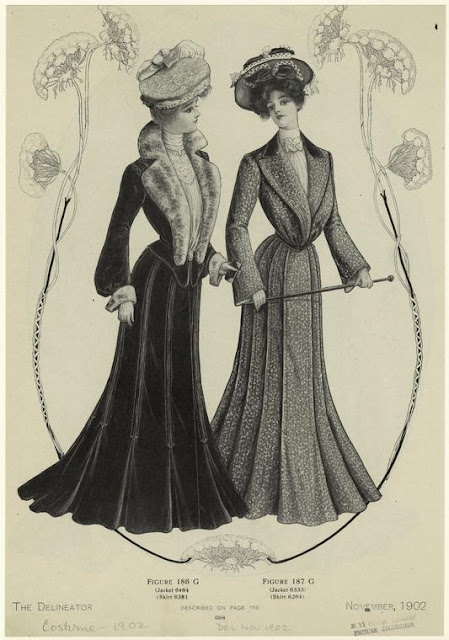The Myth of Chanel and the 1920s: I - A Sea Change
But it was the androgyny promoted by Chanel that dominated women's fashion in Europe in 1919. ... Once the matchless pace setter of individuality in fashion, Poiret snorted that her clothes resembled 'Cages lacking birds. Hives lacking bees.'
The 1910s are not a well-known decade in fashion history. Despite the success of Downton Abbey, many still contrast the loose dress of the 1920s with fitted gowns and S-bend corsets from the first decade of the twentieth century to determine that a change must have erupted at the very end of the 1910s.
 |
| Figs. 186-187, The Delineator, Nov. 1902; NYPL 816623 |
 |
| "LASSITUDE: Dinner gown, by Paul Poiret", Georges Lepape, Gazette du Bon Ton, 1913; NYPL 824778 |
At any rate, the extreme curves of the Edwardian era left along with Edward VII. The Directoire Revival instead raised up a radically different figure with slim hips and a lissome silhouette. Poiret's quote is frequently used to show that Chanel had invented her own radically different figure, but in fact there is only a small step between the body shapes favored by the two couturiers.
In addition, Poiret was a showman. He claimed to have banished the corset himself - no help from Lucile or Callot Soeurs - and delighted in creating drama. It's possible that part of his motive in making a public derogatory statement was to garner attention - a practice known today as trolling. While I wouldn't say that this must be the truth, the context of Poiret's personality really ought to be included with any discussion of his statement.
It is also misleading of Nicholson to juxtapose Poiret's quote with Chanel's dress in November of 1919. In Poiret, King of Fashion (Metropolitan Museum of Art: 2007, p. 24), the writer notes that Poiret's scathing critique of the fashionable silhouette was made in 1922, several years later. Nicholson implies that he felt threatened by the very emergence of Chanel, by the "obviousness" of the fact that she would eclipse him, but it is by no means certain that that was his motive.



Comments
Post a Comment